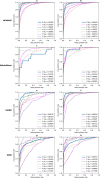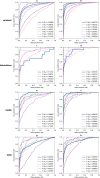Towards population-independent, multi-disease detection in fundus photographs
- PMID: 37460629
- PMCID: PMC10352300
- DOI: 10.1038/s41598-023-38610-y
Towards population-independent, multi-disease detection in fundus photographs
Abstract
Independent validation studies of automatic diabetic retinopathy screening systems have recently shown a drop of screening performance on external data. Beyond diabetic retinopathy, this study investigates the generalizability of deep learning (DL) algorithms for screening various ocular anomalies in fundus photographs, across heterogeneous populations and imaging protocols. The following datasets are considered: OPHDIAT (France, diabetic population), OphtaMaine (France, general population), RIADD (India, general population) and ODIR (China, general population). Two multi-disease DL algorithms were developed: a Single-Dataset (SD) network, trained on the largest dataset (OPHDIAT), and a Multiple-Dataset (MD) network, trained on multiple datasets simultaneously. To assess their generalizability, both algorithms were evaluated whenever training and test data originate from overlapping datasets or from disjoint datasets. The SD network achieved a mean per-disease area under the receiver operating characteristic curve (mAUC) of 0.9571 on OPHDIAT. However, it generalized poorly to the other three datasets (mAUC < 0.9). When all four datasets were involved in training, the MD network significantly outperformed the SD network (p = 0.0058), indicating improved generality. However, in leave-one-dataset-out experiments, performance of the MD network was significantly lower on populations unseen during training than on populations involved in training (p < 0.0001), indicating imperfect generalizability.
© 2023. The Author(s).
Conflict of interest statement
The authors Sarah Matta, Mathieu Lamard, Pierre-Henri Conze and Jean-Bernard Rottier declare no Competing Financial or Non-Financial Interests. The authors Clément Lecat, Fabien Basset and Romuald Carette declare no Competing Non-Financial Interests but the following Competing Financial Interests: Employee – Evolucare Technologies. The author Alexandre Le Guilcher declares no Competing Non-Financial Interests but the following Competing Financial Interests: Research & Innovation director – Evolucare Technologies; CEO – OphtAI. The author Pascale Massin declares no Competing Non-Financial Interests but the following Competing Financial Interests: Consultant – Allerga, Bayer, Novartis, Thea, Horus. The author Béatrice Cochener declares no Competing Non-Financial Interests but the following Competing Financial Interests: Consultant and clinical investigator – Thea, Alcon, Zeiss, B&L, Hoya, Horus, Santen, SIFI, Cutting Edge, J&J. The author Gwenolé Quellec declares no Competing Non-Financial Interests but the following Competing Financial Interests: Consultant – Evolucare Technologies, Adcis.
Figures




